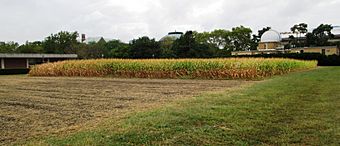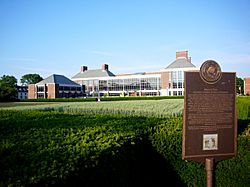Morrow Plots facts for kids
|
Morrow Plots, University of Illinois
|
|

(2013)
|
|
| Location | University of Illinois at Urbana-Champaign, Urbana, Illinois |
|---|---|
| Area | 0.8 acres (0.32 ha) |
| Built | 1876 |
| NRHP reference No. | 68000024 |
Quick facts for kids Significant dates |
|
| Added to NRHP | May 23, 1968 |
| Designated NHL | May 23, 1968 |
The Morrow Plots is a special farm field at the University of Illinois at Urbana-Champaign. It's like a science lab for plants! This field is named after Professor George E. Morrow. It is the oldest field of its kind in the United States. It's also the second oldest in the whole world.
The Morrow Plots started in 1876. It was the first place at an American college to study how corn grows. Even today, scientists still use these fields for experiments. The original field had ten large sections. Now, it has three smaller sections. On May 23, 1968, the Morrow Plots became a National Historic Landmark. This means it's a very important historical place. The University of Illinois College of ACES takes care of the fields.
What Are the Morrow Plots?
The Morrow Plots are right in the middle of the University of Illinois campus. They are located between the main grassy areas called the Main Quad and the South Quad. You can find them near the Observatory building and the Undergraduate Library.
Today, the plots have six small fields. Each one is about one-tenth of an acre in size. The two fields at the very north have been growing maize (which is another name for corn) every single year since 1876. That's a very long time!
The fields in the middle used to grow corn and oats in a cycle. In 1968, soybeans replaced the oats. The fields at the south used to grow corn for three years, then a meadow for three years. Later, in 1901, they changed to a cycle of corn, oats, and clover. In 1953, they started growing corn, oats, and alfalfa. These different planting plans help scientists learn about soil and crops.
The Underground Library Story
There's a popular story about the library next to the Morrow Plots. People say the university built the Undergraduate Library with three floors underground. This was supposedly to make sure the library didn't block the sun from the Morrow Plots.
It's true that the library is mostly underground. However, the university also wanted a big open space on that part of the campus. This was another important reason why the library was built underground. So, it wasn't just about the sun for the plants!
History of the Morrow Plots
The Morrow Plots began in 1876. Professor Manly Miles started the first experiments. He set up three fields, each about half an acre. He tried different ways of growing crops.
In 1879, Professor George E. Morrow expanded the plots to ten fields. At first, the records weren't perfect. But by the early 1900s, it became clear that changing crops each year, called crop rotation, was very helpful. It stopped the soil from getting tired and losing its goodness.
Over time, the university needed more space. So, the number of plots was reduced. Their size also became smaller. The northernmost plots are the only ones left from Professor Miles' original experiments in 1876. His other original plots are now where the University of Illinois Observatory stands.
The experiments at the Morrow Plots have taught us a lot. They showed that good soil is super important for growing lots of crops. They also proved that using science and new technology can make farms grow more than four times as much food!
Gallery



